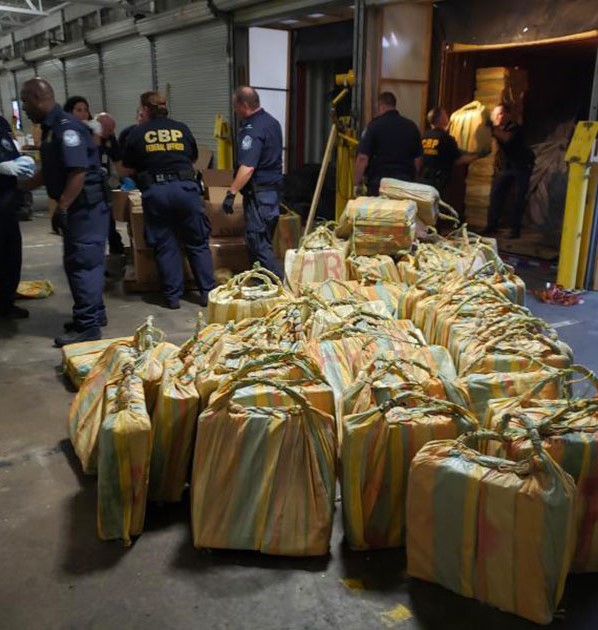When one thinks of major drug seizures, perhaps one thinks of New York City or Miami, two major gateways for illegal drugs. But it was right here in Philadelphia that one of the largest drug seizures in U.S. history occurred.
On June 17, 2019, federal, state, and local law enforcement agents and officers discovered approximately 20 tons of cocaine on the MSC Gayane, a commercial cargo ship that was bound for the Packer Avenue Marine Terminal. The cocaine had an estimated street value of $1.3 billion. The cocaine was ultimately bound for Rotterdam.
Earlier this month, the final shipboard crew member charged, Aleksandar Kavaja, 28, of Montenegro, was sentenced to prison for more than seven years on charges of conspiracy to possess with intent to distribute cocaine on a vessel subject to the jurisdiction of the United States. Other crew members were sentenced earlier to similar prison terms.
“As the sentences for the illegal conduct in this case continue to happen, they serve as a reminder that drug smuggling operations will be uncovered one way or another,” Acting U.S. Attorney Jennifer Arbittier Williams said after the sentencing of two of the smugglers on Aug. 2. “Prosecutors in our office have been working non-stop to pursue justice since the MSC Gayane docked in the port of Philadelphia over two years ago, and we will not stop until the case is closed.”
Prior to the seizure in 2019, according to the Feds, on multiple occasions during the Gayane’s voyage and while at sea, crew members, including those sentenced to prison, helped load bulk packages of cocaine onto the ship from speedboats that approached the ship in the middle of the night. Crew members used the ship’s crane to hoist cargo nets full of cocaine onto the ship and then hid the cocaine in the ship’s shipping containers.
The crew members bent railings on the ship and pulled back doors on the shipping containers so they could fit the huge quantities of cocaine into the containers. After hiding the drugs among legitimate cargo, crew members used fake seals to reseal the shipping containers in which they had stashed the cocaine to disguise their clandestine activities and contraband. Crew members operated mobile “narco” phones to coordinate the bulk cocaine smuggling with others on land and recruited other crew members while at sea to assist in the smuggling operation.
On June 8, 2019, Casey Durst, the director of field operations for the U.S. Customs and Border Protection, announced the record drug seizure. “The MSC Gayane is the largest vessel seized in U.S. Customs and Border Protection’s 230-year history and follows the record seizure of almost 20 tons of cocaine discovered on the vessel,” Durst said. ““Seizing a vessel of this size is an unusual enforcement action for CBP but is indicative of the serious consequences associated with an alleged conspiracy by crewmembers and others to smuggle a record load of dangerous drugs through the United States. This action serves as a reminder for all shipping lines and vessel masters of their responsibilities under U.S. and international law to implement and enforce stringent security measures to prevent smuggling attempts such as this. Because of our officers’ efforts, over $1 billion of dangerous narcotics was taken off the streets. I have no doubt that our officers saved lives and significantly impacted transnational criminal organizations with this interception.”
The CBP explained that there was a midstream boarding by a multi-agency team consisting of CBP, Homeland Security Investigations, the U.S. Coast Guard, the Coast Guard Investigative Service, the Philadelphia Police Department, the Delaware State Police, and the Pennsylvania State Police. The team detected anomalies while examining seven shipping containers aboard the Liberian-flagged ship. The boarding team escorted the ship to its berth in South Philadelphia.
The law enforcement officers and agents offloaded more than 35,000 pounds of cocaine. The officers and agents posed with the drug haul, justifiably proud of their efforts.
The Feds have not been forthcoming on details on just how they came to suspect that the Gayane held the 20 tons of cocaine, be it from electronic surveillance or an informant. Nor have they named the transnational drug organization or organizations that planned the historic smuggling operation.
With such a large quantity of drugs, perhaps the transnational drug operation was organized by Balken criminals with the Russian Mafia (called the “Vory” or “Thieves in the Law” in Russian), along with a Colombian cartel, and a major European illegal drug distributor, such as the Italian Cosa Nostra, the Camorra, or the “Ndrangheta.”
The billion-dollar bust saga would make a hell of a good cable mini-series.
Paul Davis’ Crime Beat column appears here each week. He can be contacted via pauldavisoncrime.com.





